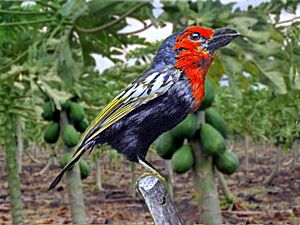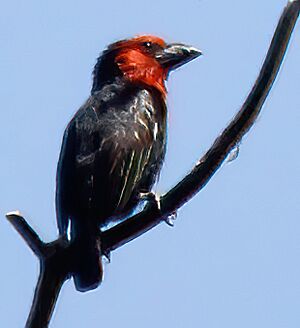Black-billed barbet facts for kids
Quick facts for kids Black-billed barbet |
|
|---|---|
 |
|
| Conservation status | |
| Scientific classification | |
| Genus: |
Lybius
|
| Species: |
guifsobalito
|
The black-billed barbet (scientific name: Lybius guifsobalito) is a colorful bird. It belongs to the Lybiidae family, which are often called African barbets. These birds are known for their bright feathers and strong beaks.
Contents
Where Black-billed Barbets Live
This bird species lives in a very large area of Africa. You can find them in countries like Cameroon and Eritrea. They also live in parts of the Democratic Republic of the Congo. Their home stretches from eastern Sudan to western Ethiopia. You can also spot them in western Kenya, northern Tanzania, and Uganda.
What Kind of Places They Like
Black-billed barbets live in many different places. They prefer areas that are between 900 and 2,200 meters high. These birds like open forests and the edges of forests. They also live in woodlands and savannahs. You can find them in scrubs, gardens, and farms too. They especially like places with fruit-bearing trees.
What Black-billed Barbets Look Like
These are medium-sized birds. Male black-billed barbets have a wingspan of about 7.9 to 9.4 centimeters. Their tail is usually between 4.5 and 5.4 centimeters long. The beak measures about 1.9 to 2.2 centimeters. Female barbets are about the same size as males. It is hard to tell them apart just by looking at their size.
Both male and female birds have shiny blue-black feathers. Their wings and belly are a bit more brown. A bright red or red-orange color covers their face, throat, and upper chest. The top of their wings has thin yellow or white lines. Their beak is strong and black. The skin around their eyes is gray, and their eyes are reddish-brown. Their legs and feet are grayish-black. Young birds have feathers that are not as bright as the adults.
This species is closely related to two other barbet types. These are the Lybius torquatus and Lybius rubrifacies.
How Black-billed Barbets Live
The black-billed barbet is a very adaptable bird. This means they can live well in different environments. Their main food is fruits like figs, guavas, and papaya. They also enjoy eating various berries. Besides fruits, they also eat insects. Their diet includes beetles, ants, and termites.
These birds usually live in pairs. Sometimes, you can see them in small groups. These groups can have up to seven birds. They make different sounds. One sound is a low growling noise. They also make a series of two-syllable calls that sound like "koop-pup."




